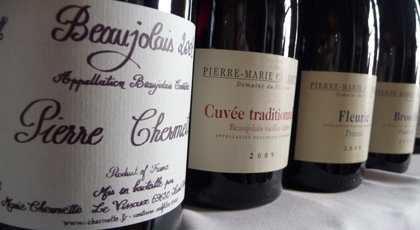Dr Vino's wine blog
wine talk that goes down easy
Domaine des Baumard: under screwcap since 2005
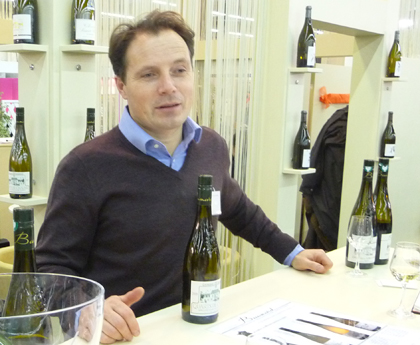
Florent Baumard makes gorgeous, beautifully precise wines from Savennieres, Coteaux du Layon and Quarts de Chaume, among other appellations. His family has been making wine there since 1634. But since 2005, in a move somewhat at odds with the region and age-worthy wines, he’s been putting the wines all under screw cap.
The experiment first started in 2003. Frustrated by the different evolution of wines under cork, Baumard started with the Clos du Papillon bottling from Savennieres: Half the production went under cork, half under screw cap (aka Stelvin closure). Within two years all the still wines were under screwcap. I tasted the 2007 Clos du Papillon Savennieres and didn’t find it reduced but it was tight, presumably from youth. I also had a 1999 Clos de Saint Yves Savennieres, bottled under cork, that wasn’t showing too much evolution; instead it was rich, layered and deliciously complex as chenin blanc can be. So is it the right call? Who knows. One day in the future, it would be fascinating to taste some of those ’03s bottled under different closures.
I tweeted about the screw caps–not exactly breaking news, but interesting nonetheless–and someone joked if Florent wasn’t just a little bit Australian. No, he replied, but after his saga with verdelho, he admitted he admires their freedoms.
Loire: 2008, 2009, 2010 and more!
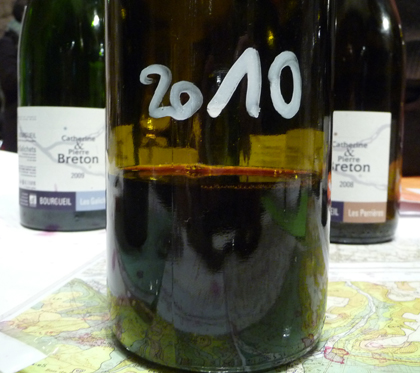
The Loire has such diverse wines–red, white, pink, sparkling, sweet–that there’s enough to keep a wine enthusiast’s attention for a long time. Add to that a refreshing level of acidity in the wines and there’s a lot to interest a foodie too since the wines pair so well with food. And of course they offer some of the best values in the wine world.
I had the opportunity to meet vignerons and taste over 300 wines last week in situ. Some of the wines were embryonic, barely finished fermenting and difficult to assess. Others had glorious amounts of age on them, a decade or three, including Domaine Huet and Domaine Baudry. (As I mentioned in a previous post, most of my time was at the wine trade show, the Salon des Vins de Loire, which tends to favor breadth over depth. But I did get to poke around in a couple of troglodyte caves hewn from limestone.)
I also blind tasted 70 Loire wines at the NY offices of Wine & Spirits a couple of weeks before I left. As a general sketch for such a large region, I’ve reached the following conclusions about the three vintages now or soon to be on the market: 2008 was noted by higher acidity and in some subregions, lower yields; 2009 has slightly rounder wines, which can be a good thing or a bad thing depending on your perspective and the wine; and 2010 is an exciting vintage, somewhere in between the two previous ones stylistically. I will add some more flesh to these bare bones in a future posts, particularly for Muscadet, some cabernet franc, and one heirloom variety. So stay tuned for some related posts in coming days and weeks.
The G Spot, The Titanic, Verdehlgold – punny French labels!
All too often, French labels are stuffy. However, when it comes to good vin de table wines, puns and word play abound. Consider these from the Loire:
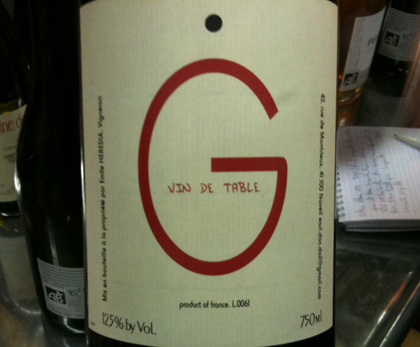
This is a tasty yet tannic (thanks six-month maceration!) gamay from Emile Heredia of Domaine de Montrieux in the Coteaux du Vendômois. It’s labeled simply “G.” With a spot over it. He told me, “The anglais say it doesn’t exist–but they haven’t looked for it!” Read more…
Celebrate Beaujolais with a stunning 2009 cru
Beaujolais is in the air today–and not just because it is being dropped on an unsuspecting world via airfreight. It is Beaujolais nouveau day, a marketing contrivance that seems to have less impact every year.
But it’s a good springboard for talking about the spectacular 2009s from the region’s smaller appellations, known as “crus.” I was initially skeptical, but have tasted through several and found them excellent indeed! The warm growing season resulted in richer wines but the best producers were able to keep the alcohol in check; if you haven’t been a fan of the style in previous vintages, the 09s could have what it takes to bring you around to the pleasures of Beaujolais. Here are a few notable ones, deserving of a spot on your table, Thanksgiving and beyond.
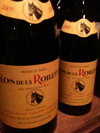 Clos de la Roilette: Alain Coudert produced two stunning wines from his Fleurie vineyard. The regular cuvée has a gorgeous nose followed by delicious balance of fruit, freshness, and intensity that will convince many a Beaujolais skeptic. I bought a magnum of this wine for the biggest impact at my Thanksgiving table. The “cuvée tardive,” visible from across the aisle thanks to the new neck label, is a superb wine to tuck away for a few years in the deepest, darkest spot in your cellar. It’s more dense, structured and closed now than the regular bottling but will doubtlessly evolve into a a real stunner.
Clos de la Roilette: Alain Coudert produced two stunning wines from his Fleurie vineyard. The regular cuvée has a gorgeous nose followed by delicious balance of fruit, freshness, and intensity that will convince many a Beaujolais skeptic. I bought a magnum of this wine for the biggest impact at my Thanksgiving table. The “cuvée tardive,” visible from across the aisle thanks to the new neck label, is a superb wine to tuck away for a few years in the deepest, darkest spot in your cellar. It’s more dense, structured and closed now than the regular bottling but will doubtlessly evolve into a a real stunner.
Marcel Lapierre: The first bottle of 2009 Lapierre Morgon seemed a bit high in alcohol to me and I wondered if there was a shift at the estate in that direction. But why would they mess with success? The second bottle I had was riper than the 06s and 07s, but still had the alluring aromatics, delicate structure and the lively snap of acidity that has been the house calling card for many a vintage. Although Marcel Lapierre died earlier this year, I’ll save my remaining bottles of this wine to toast him in future years.
Pierre Chermette: Pierre-Marie Chermette always produces reliable wines from the Beaujolais on up to his crus; the 09s are particularly stunning. For immediate pleasure, try the Beaujolais; for later delight, tuck away bottles of his Fleurie, which exhibits a lot of complexity on the nose and the palate, yet is tightly wound today.
Jean-Paul Brun, Terres Dorées: Although not a cru, the Terres d’Orées, “L’Ancien” 2009 Beaujolais is a terrific value, ready to drink either on a weeknight, weekend, Thanksgiving or not.
St. Jean de la Gineste – a value vielles vignes carignan
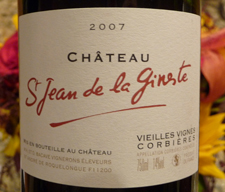 Carignan. When Bacchus was handing out the mellifluous names of grape varieties in French–Cabernet, Chardonnay, and Merlot roll easily of the anglophone tongue–he had apparently run out by the time he got to Carignan. In America it is often called carignane when planted, if at all, on domestic soil. But even in the Languedoc, in the south of France where the grape proliferates, reasonable people like Jancis Robinson have dumped on the grape for tasting like battery acid (or something).
Carignan. When Bacchus was handing out the mellifluous names of grape varieties in French–Cabernet, Chardonnay, and Merlot roll easily of the anglophone tongue–he had apparently run out by the time he got to Carignan. In America it is often called carignane when planted, if at all, on domestic soil. But even in the Languedoc, in the south of France where the grape proliferates, reasonable people like Jancis Robinson have dumped on the grape for tasting like battery acid (or something).
By contrast, Becky Wasserman told me she considers Carignan to be “the Pinot Noir of the south,” especially given its high natural acidity. Wasserman, an exporter of French wine, includes one Carignan in her portfolio and it is a value, particularly now as the weather turns chilly. The family-run St. Jean de la Gineste, in the Corbieres appellation, cultivates some old vines of Carignan, ferments the grapes in a neutral, concrete vessel, and blends in 15 percent grenache. I purchased the resulting 2007 wine at New York Vintners for about $14 and found this true taste of Carignan to be worthy of respect. Dark in the glass, the un-pinot-like 14% alcohol makes it a bigger wine but the rustic grape tannin is unadorned by oak and then there’s the good acidity. Now if only I could rustle up some cassoulet…
Marcel Lapierre dies at 60
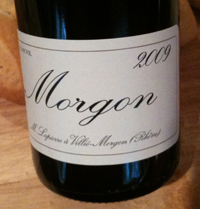 Marcel Lapierre’s wines have brought me much pleasure. When I bring out one of his wines, with the beautiful script label and red wax capsule, my wife is always instantly happy. They are the rarest of wines, serious and structured, ready to drink now or later, with a few years age on them. They are made from organic (and horse-tilled) vineyards with minimal intervention in the cellar, including sulfur. But what really makes them rare is that they are also affordable: I bought a case of his Morgon 2009s for $19.95 a bottle. (find this wine)
Marcel Lapierre’s wines have brought me much pleasure. When I bring out one of his wines, with the beautiful script label and red wax capsule, my wife is always instantly happy. They are the rarest of wines, serious and structured, ready to drink now or later, with a few years age on them. They are made from organic (and horse-tilled) vineyards with minimal intervention in the cellar, including sulfur. But what really makes them rare is that they are also affordable: I bought a case of his Morgon 2009s for $19.95 a bottle. (find this wine)
So it is small wonder on this basis alone that he attracted a wide following among winemakers–beyond Beaujolais and even beyond France–as well as consumers. Add to this his infectious bonhomie as Tim Atkin described him in Saveur: “Lapierre is just Lapierre, a big, hulking, witty chunk of humanity with enough enthusiasm and joie de vivre for half-a-dozen men.”
Yesterday, sad news came from Morgon that Lapierre had died too young, at the age of 60 from melanoma. His son Mathieu has been active in the cellar for a number of vintages and will, presumably, carry on the tradition of crafting these supremely pleasurable wines.
Bourgogne Montre-Cul struts its stuff
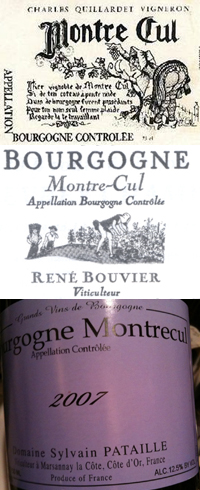 Where can you find a growing area called “show your ass”: Santa Barbara, Barossa, or Burgundy?
Where can you find a growing area called “show your ass”: Santa Barbara, Barossa, or Burgundy?
If you guessed Burgundy, you’re right! The Bourgogne Montre-Cul (or Montrecul or en Montre-Cul) vineyard/appellation lies at the north end of the Cotes de Nuits, near Marsannay. According to legend, the slopes were so steep that when the women pickers bent over to pick the grapes, they gave everyone below a bit more of a view than just the hills. While this may sound like Hugh Hefner’s vineyard playland, the women were likely of somewhat sturdier stock than those you’d find at the Playboy Mansion. (Montre Cul really does sound like it’s something out of the French equivalent to John Cleese’s Hungarian phrasebook. Diner: “Je voudrais un Montre Cul.” Sommelier: SLAP.)
I learned of this appellation while tasting Sylvain (“The Sylvainator”) Pataille’s tasty 2007 red wine from the region. There are not many acres of vineyard left in the tiny region, which has largely been engulfed by Dijon. As you can see to the right, his label is a little less artistic than other depictions.
Wine children’s book, underage, China TV – sipped & spit
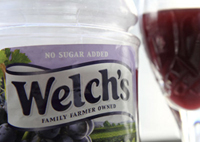 SIPPED: spiked juice
SIPPED: spiked juice
The good folks at Gizmodo sacrificed their own palates by turning Welch’s grape juice into, well, fermented grape juice using a product called Spike Your Juice. Just don’t let the WSWA know that underage might be able to get ahold of this for cheaper than wine.
SIPPED: wine book for kids
An illustrated book for children that details the life of the vine and wine’s history back to Roman times will be appearing soon–in France. It’ll keep them away from the fermented Welch’s, no doubt! (But then again, when you have self-serve wine tanks, why would you ever need to ferment Welch’s?)
SPIT: shopping for wine with kids
A Tesco in the UK refused to sell a dad a bottle of wine with his groceries. Why? Because he was with his eight-year-old daughter and she didn’t have valid ID. [Mirror.co.uk]
SIPPED: Bordeaux & Asia 1
After having his wine mentioned in a Drops of the Gods spin-off comic, a small Bordeaux vintner has withdrawn his wine from the market in the hope of preventing speculation and escalating prices. He’s now screening buyers and still offering the wine at €18. How long before there’s a secondary market for Château le Puy? [Guardian]
SIPPED: Bordeaux & Asia 2
A sequel to the popular Chinese TV show, “Cherish Our Love Forever,” is now shooting on location in Bordeaux. Inquiring minds wonder if it will do for Bordeaux in China what Sideways did for pinot noir here? [AFP]
SPIT: Bordeaux & Asia 3
The Economist has a short piece on wine in Hong Kong. They cite prices for Château Lafite Rothschild, the market leader, have roughly doubled in the past six months; “Sniff its bouquet,” they write “and the wine boom has hints of tulip mania.”
